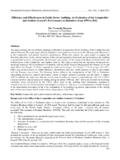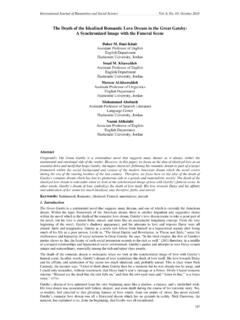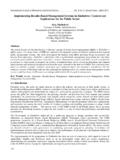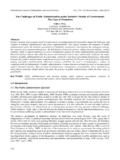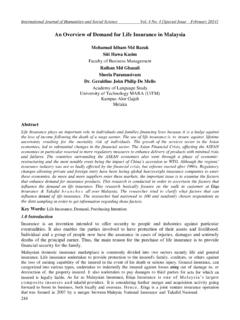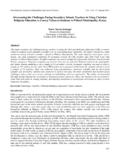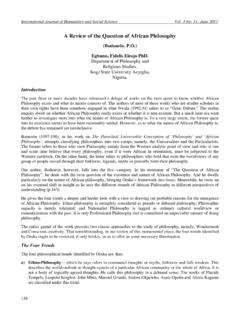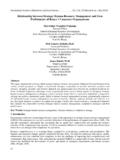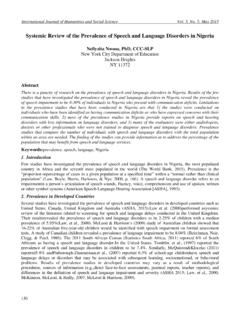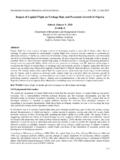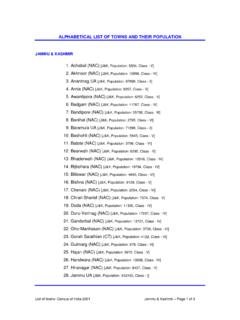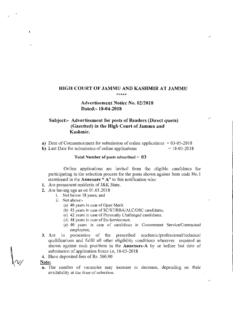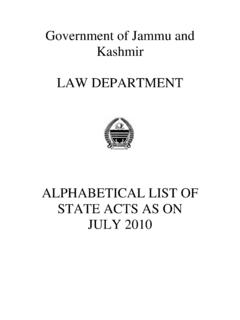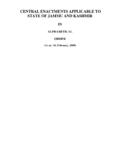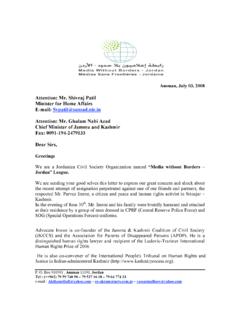Transcription of Kashmir Conflict: Solutions and Demand for Self …
1 International Journal of Humanities and Social Science Vol. 1 No. 6; June2011. Kashmir Conflict: Solutions and Demand for Self-determination Rashmi Sehgal School of History, Politics and Strategic Studies The National University of Malaysia, Selangor, Malaysia. E-mail: Abstract Besides being the longest unresolved dispute in the World, Kashmir is also a nuclear flash-point between two of South Asia's enemy countries, India and Pakistan. India and Pakistan, both nuclear powers have several times engaged in fighting over the Kashmir region. Most Kashmiris, on the other hand have been fighting for their right of self-determination recognized by the UN for many decades.
2 The promise made by the first Indian Prime Minister, Jawaharlal Nehru which is also envisaged in the Instrument of Accession of 1947 to let Kashmiris decide their future through a Plebiscite still eludes Kashmir . In the past two decades, the region has been witness to a lot of violence which has also strained the relations between India and Pakistan. There have been several rounds of talks on Kashmir between governments of India and Pakistan. Sadly, there has not been any substantial positive outcome in resolving this dispute. The Kashmir dispute has been analyzed several times in terms of its impact, economical or political, on India, Pakistan and also Kashmir .
3 An analysis through a Kashmiri point-of-view as to what the Kashmiris want and how the two decade long conflict has affected their resolve for self-determination makes for an interesting research. The data for this study was collected in Kashmir through a questionnaire survey. 166 questionnaires were collected from five main districts of J&K. Different possible Solutions to the Kashmir conflict were presented to the respondents and their views were sought. This paper thus reports the results of this exercise and discusses the same in light of Kashmiris' aspirations and realpolitik of south Asia. Keywords: Kashmir , Self-determination, Human Rights Violation, India-Pakistan, conflict.
4 1. Introduction People of Jammu and Kashmir have been struggling for their right of self-determination from more than six decades. The issue of Kashmir started just after India s independence and the birth of Pakistan in 1947. At that time there were around 560 princely states under British India and Kashmir was one of them. The delay in deciding Kashmir s future by Maharaja Hari Singh - the last king of independent Kashmir - after the British left was the root cause of Kashmir conflict. The tribal invasion caused by raiders from Pakistan made the Maharaja feel insecure and he decided to seek help from India.
5 India s viceroy Mountbatten promised him militarily help and in return Maharaja signed the Letter of Instrument of Accession to India , which stands controversial ever since. And with that Instrument of Accession, the Kashmir dispute has stared into the faces of the two nuclear neighbours for more than six decades now. On 2nd November, 1947 India s first Prime Minister Pandit Jawharlal Nehru announced on All India Radio that Kashmir future will be decided by the means of plebiscite . However the promise of plebiscite is still pending. India claims that people s participation in elections shows that people are happy and there is no Demand for any plebiscite.
6 Pakistan and those opposing this viewpoint on the other hand say that the elections have never been free and fair in Kashmir and when they have been so, the people have voted for governance issues like roads, electricity and other amenities, and not for sorting out the Kashmir dispute. Meanwhile, the number of people having lost their lives during the past two decades of Kashmir is overwhelming with some agencies putting the number at around 89,000 and the number of enforced disappearances at 10,000. There are around 600,000 to 700,000 Indian troops in Kashmir and aspersions have often been casted on the freeness and fairness of elections conducted under such heavy military presence.
7 On the other hand, the Indian army has often been accused of grave human rights violations like torture, custodial deaths, disappearances, rape and molestation in the state. The army has often invited censure from international human rights agencies like Amnesty International. A statement issued on the floor of the J&K Assembly by the Deputy Chief Minister on August 1st 2006, revealed that there are more than 600,000 security forces in Jammu Kashmir . That means the ratio of deployment to people is 1 soldier for every 18 persons. This is an incredibly high concentration of troops for an area whose population is not more than 12 million.
8 Officially the number of militants operating in J&K has come down to 1500. Despite such huge military setup in J&K and several efforts to bring this dispute to an end, a long-lasting solution eludes the people of Kashmir who bear the main brunt of this conflict. 188. Centre for Promoting Ideas, USA Therefore this study looks at the Solutions to this dispute from the perspective of the people of Kashmir and presents their views in the light of realpolitik of the region. The results of this study show that there is an overwhelming desire for independence in Kashmir , however at the same time this does not look like a feasible solution to this dispute.
9 That Kashmir is a vexed issue, involving interests of different stakeholders and thus making it difficult to solve this conflict is substantiated by the results of this study conducted in five main districts of the state. The rest of this paper takes the following structure. The second section reviews the related literature. The third section discusses the research design. In the fourth section, findings of the study are presented and discussed. In the last section, conclusion is provided. 2. Literature review Being one of the intractable unresolved conflicts in the world, the Kashmir issue has attracted attention of many researchers, scholars and authors.
10 A number of books and articles have been written on the Kashmir conflict. This review of literature presents a snapshot of some important related works. India, Pakistan and the Kashmir Dispute by Robert 1994 looks at almost every detail of the Kashmir conflict, starting from the very context of the issue to boundary intricacies. An excellent analysis, it however focuses less on the issue of self-determination of Kashmir . Another eminent author, a British historian Alstair Lamb in his book Kashmir : A Disputed Legacy, 1984-90 (1991) argues about the veracity of the Instrument of Accession and concludes that it was not signed by Maharaja Hari Singh of Kashmir on 26th of October 1947, a day before the Indian troops arrived in the Kashmir Valley to defend Kashmir against the raiders from the Northwest Province of Pakistan.
